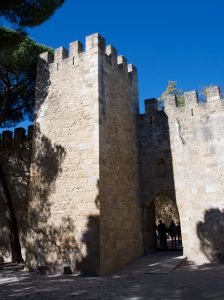 Our group met with our tour guide after breakfast to start the day with a walk through the Alfama neighborhood, which dates back to the Visigoths from the sixth to the 8th centuries AD. Near the sea, it became the home of Lisbon’s fishermen and mariners. We walked up to São Jorge Castle, the highest point in town. We were looking forward to going to the castle because our son had told us that he enjoyed doing just that. We were not disappointed. Typically, castles are fortifications while palaces are royal residences, but the Portuguese royal family lived there for several centuries. After the royal family relocated, the castle became a military garrison. It was declared a national monument in the 20th century.
Our group met with our tour guide after breakfast to start the day with a walk through the Alfama neighborhood, which dates back to the Visigoths from the sixth to the 8th centuries AD. Near the sea, it became the home of Lisbon’s fishermen and mariners. We walked up to São Jorge Castle, the highest point in town. We were looking forward to going to the castle because our son had told us that he enjoyed doing just that. We were not disappointed. Typically, castles are fortifications while palaces are royal residences, but the Portuguese royal family lived there for several centuries. After the royal family relocated, the castle became a military garrison. It was declared a national monument in the 20th century.
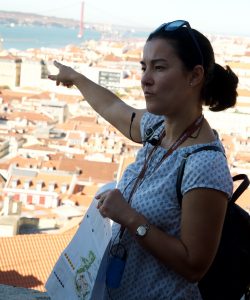 The views from the castle are spectacular. You can see the Rio Tejo, the 25th of April Bridge (it looks ike the Golden Gate), and even Avenida Liberdade, all far below.
The views from the castle are spectacular. You can see the Rio Tejo, the 25th of April Bridge (it looks ike the Golden Gate), and even Avenida Liberdade, all far below.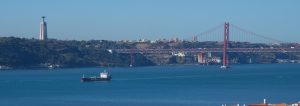
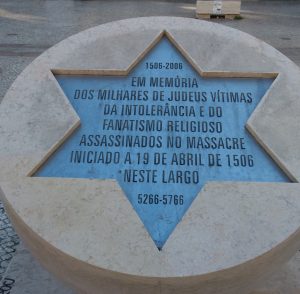 We proceeded to the Baixa area, a valley between two hills, and explored the “old”neighborhoods, where there are remnants of the Moorish and Jewish cultures. We saw the square in which many atrocities we are committed at a time when no religious tolerance was allowed.
We proceeded to the Baixa area, a valley between two hills, and explored the “old”neighborhoods, where there are remnants of the Moorish and Jewish cultures. We saw the square in which many atrocities we are committed at a time when no religious tolerance was allowed.
Several of our new friends joined us for lunch. I enjoyed shrimp salad, while Nick feasted on sea bass with veggies. We were on our own for the afternoon, and some of us decided to go to the National Tile Museum. Finding the right bus at the right bus stop is all part of the adventure. Off we went!
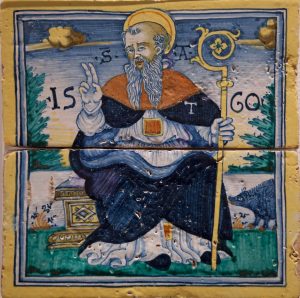 As I have said, tile is very important in Portugal, and here we saw the progression of telework through the centuries. On the bus on our way back to our hotel, I heard some English-speaking tourists saying they were going to Sintra the next day. I gave them our train tickets, and they were delighted. We were pleased that they were being put to good use!
As I have said, tile is very important in Portugal, and here we saw the progression of telework through the centuries. On the bus on our way back to our hotel, I heard some English-speaking tourists saying they were going to Sintra the next day. I gave them our train tickets, and they were delighted. We were pleased that they were being put to good use!
That evening, we walked to the restaurant in which we would be having dinner together. Formerly a casino, the room was beautifully appointed. We enjoyed many hot and cold antipasti, including fava beans dressed with oil and garlic, roasted chick peas, and olives. We had a choice of roast pork or salmon for the main course.
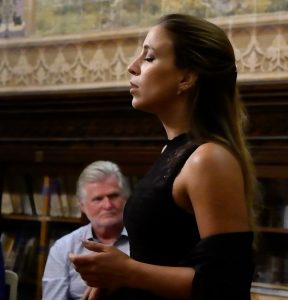 We knew in advance that after dinner, we would be hearing fado music, which is unique to Portugal. The word “fado” means fate. Fado songs tell of the men who have sailed across the sea and the women they left behind who pined for them. The songs can be performed by men or women who are accompanied by very talented guitarists, some playing a twelve string guitar. We were impressed by the singer, because her voice was lovely, dramatic and soulful. Eventually we discovered that she was the opening act for another female fado singer. We bought their CD and are now enjoying the memory of our evening’s entertainment.
We knew in advance that after dinner, we would be hearing fado music, which is unique to Portugal. The word “fado” means fate. Fado songs tell of the men who have sailed across the sea and the women they left behind who pined for them. The songs can be performed by men or women who are accompanied by very talented guitarists, some playing a twelve string guitar. We were impressed by the singer, because her voice was lovely, dramatic and soulful. Eventually we discovered that she was the opening act for another female fado singer. We bought their CD and are now enjoying the memory of our evening’s entertainment.
16, 508 steps
We loved fado music and Tony was inspired to buy a beautiful Portuguese guitar on the internet!
Yes, the music is beautiful, isn’t it? I look forward to seeing the guitar!